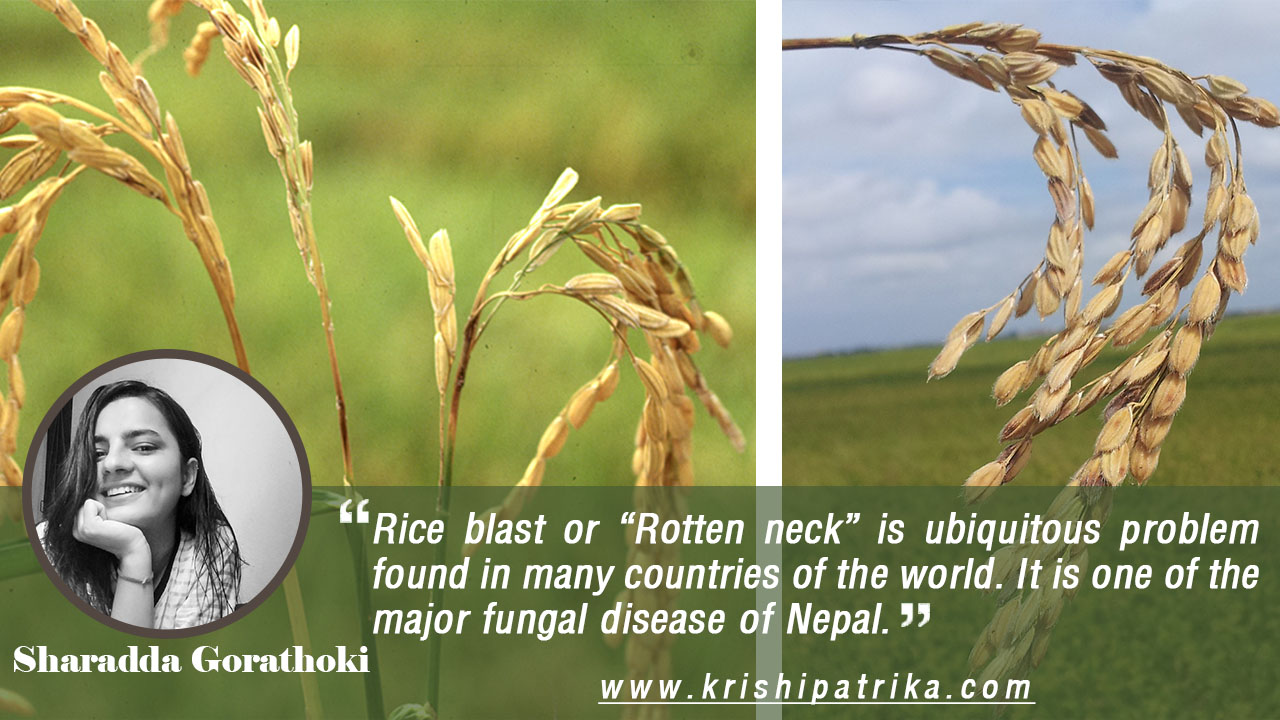
Rice blast or “Rotten neck” is ubiquitous problem found in many countries of the world. It is one of the major fungal disease of Nepal.The fungus that causes rice blast is called Magnaporthe oryzae.
Favourable conditions:
1. Application of excessive doses of nitrogenous fertilizer.
2. Low night temperature(between15-20°or less than 26°c)
3. low soil moisture condition.
4. More number of rainy days, longer duration of dew, cloudy weather.
5. High relative humidity(93-99%).
6. Intermittent drizzles
7. Slow wind movement and availability of collateral hosts.
- Symptoms:
The fungus attack all aerial parts of rice plants (leaves, leaf collar, neck and panicle, pedicel, and seeds) at all stage of growth .
Leaves: Small specks appears which subsequently enlarge into spindle-shaped spot varying in length from 0.5cm to several cm. Center of spot is gray or white having brownish or reddish border(fig 1).The spots join together as the disease progresses and large area of leaves dry up and wither.
Leaf collar: Junction of leaf and stem sheath is termed as collar. Necrosis appears at the junction of two tissue and extend few millimeter into and around the sheath (fig 2) Collar infection can kill the entire leaf.
Rice neck and Panicle:
- Rice’s neck refers to the portion of the stem that arise above leaves and support the seed head and panicle.
- At the flower emergence fungus attacks the neck.The neck region become brownish-blackened and shriveled this condition is termed as “black neck” or “rotten neck”or “panicle blast”.
- In early neck infection,grain filling does not occur and panicle remain erect like a dead heart caused by stem borer whereas partial grain filling occurs in late infection of fungus.
- Small brown to black spot appears on glumes of heavily infected panicles .Gray-brown lesions appears on panicles branches, spikes, Spikelet. Fig (3 and 4)
Seeds: Seeds are not produced when pedicel become infected (condition called blanking). Recent information shows Fungus can affect seed by infecting floret as they mature. Symptoms of rice blast on seed shows brown spots, blotches .
Prevention:
- Remove crop stubbles at the time of field preparation.
- Grow blast resistance varieties like sukkha(1-6)series, hardinath-1, Radha-4, Chandannath-1, chandannath-3,chaite-2 etc
- Use salt-sorted seeds in 15% brine solution.e.g Remove floating seed .salt sorted seed can be used for seeding after washing with fresh water and slight air drying.
- Apply recommended doses of chemical fertilizers(100:30:30 NPK kg/ha), apply nitrogen in two split top dress.
- Regularly remove weed to maintain humidity.
- Proper water management practices should be done.
Control:
- Treat seed with tricyclazole 75% WP@1g/kg seed or carbendazim 50%WP@2g/kg seed . Seed treatment should be done 3 days before seeding.
- Infected seedling should be treated with tricyclazole 75%WP@1g/l at least 3 days before transplanting.
- Garlic extract @higher doses and neem extract @4ml/15ml are best to control.
- Fungicides such as Bordeaux mixture, Hinosan (1.5ml/l) ,Blitox-50(0.3%) etc should be used. Spraying is done in seed, seedbed, tiller and neck emergence stage.
- Tricyclazole 22% + Hexaconazole 3% SC fungicide could be used to control rice blast at weekly interval starting from the booting stage for three times.
Writer : Sharadda Gorathoki









